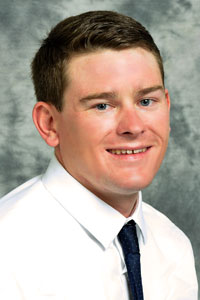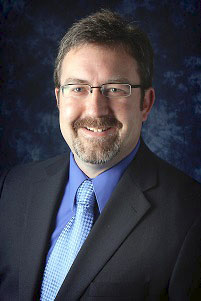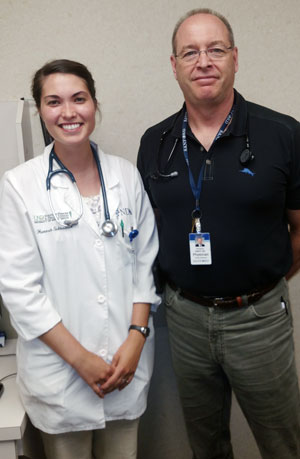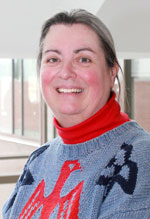Targeted Rural Health Education
A new writing project gives medical students a better understanding of rural community health needs.
By Stacy Kusler on

John "Jack" Stacy, a Wyoming native and 2nd year medical student at the University of North Dakota School of Medicine & Health Sciences (UND SMHS), has always had an interest in making healthcare more accessible to those in rural areas. He's also always enjoyed writing. It was no surprise, then, that he was one of the first students to participate in a new project that combines both of these interests.
The Targeted Rural Health Education, or TRHE ("tree"), project made its North Dakota debut in the spring of 2017 when it was introduced to members of the Rural Health Interest Group (RHIG), with support from the North Dakota Rural Health Association (NDRHA) and chair of the UND SMHS Department of Family and Community Medicine, Dr. David Schmitz.

This project, modeled after a similar program in Idaho, charges students with the task of writing an educational piece for rural community members about a top health need in that community. Many students are already participating in rotations, clinicals, or shadowing experiences in rural areas throughout the state. The TRHE project encourages and supports those students to dive deeper into the health issues facing the community so they can then educate the local public through the TRHE project. "I am hopeful that the TRHE project will provide not only a valuable community service but, at the same time, teach and empower our students to be more attuned to community needs and better prepared to meet those needs in their future careers," Dr. Schmitz explained.
...the TRHE project will provide not only a valuable community service but, at the same time, teach and empower our students to be more attuned to community needs and better prepared to meet those needs...
Top health needs for every hospital community in North Dakota are identified through their most recent Community Health Needs Assessment (CHNA), which the Center for Rural Health (CRH) at the UND SMHS archives on its website. Through the CHNAs, the students are able to review identified community health needs and choose a top need that they would like to explore on paper.
For Stacy, a board member for RHIG, choosing a topic was easy; he chose to do his rural shadowing experience at Catholic Health Initiative (CHI) Oakes Hospital in Oakes, N.D. Through its most recent CHNA, which was conducted in June of 2016, the Oakes community identified Mental Health in Adults and Children as one of its top three health priorities. "When I discussed the project with the physician I shadowed, Dr. Katie O'Brien [MD, 2006, UND SMHS], she pointed out mental illness and lack of psychiatric care in the Oakes area as a major problem. I did some research on solutions to the lack-of-access problem and was excited especially by telemedicine as an option," Stacy said.

Hannah Schradick, a medical student and RHIG board member in her 3rd year at UND SMHS, chose a similar topic for her TRHE project, which she completed in her home town of Wahpeton, N.D. Following a discussion with the hospital administrator at CHI St. Francis Health (Breckenridge, Minn.), Schradick learned that mental health was also a prevailing concern in southeast North Dakota. With contributing insights from local physician Dr. Patrick Emery, Schradick wrote her educational piece about supporting loved ones who may be experiencing depression.
Choosing a topic might have been easy for both Stacy and Schradick, but writing the articles proved to be a little more challenging. That's where Kay Miller Temple, MD, Web Writer for the CRH, stepped in to help. Dr. Miller Temple is a physician who left the bedside for the keyboard by earning her Masters in Journalism and Mass Communication in 2013 after 30 years of medical practice. She continues to contribute to the health of people and communities through her health writing. Dr. Miller Temple is the writing advisor to students participating in TRHE, helping them understand the techniques of "plain language" writing. She has successfully mentored both Stacy and Schradick through the completion of their TRHE articles; a third student's article is nearly finished. "I think the biggest surprise for the student doctors is the sudden permission to actually use plain language. They've just spent their undergraduate years proving their academic excellence with complex words and long sentences," Miller Temple said. "With plain language, they experience that simple and short has real power."

Stacy agreed that "remember the audience" was a comment he often received on drafts. "Kay was a great help," he added. While the final goal of the project is a published writing piece in a local news source, the benefits of TRHE extend beyond the written word. The goal of the entire TRHE project is giving students both a professional growth experience and a deeper understanding of the community in which a student is learning. "Being a doctor involves leadership," Dr. Miller Temple said. "Going through the TRHE steps to get information published shows student doctors how, as health leaders, they can impact a community in ways that extend past what they do for patients during a clinic visit or a hospital stay."
As for the future of the TRHE project, Dr. Schmitz has goals that extend beyond North Dakota's borders. As the president of the National Rural Health Association (NRHA), the moderator of content for the Rural Health website maintained by the World Organization of Family Doctors, and with close connections to the National Organization of State Offices of Rural Health (NOSORH), Dr. Schmitz is helping students bring this project to the national stage. "We hope to have many more states and schools make a difference locally while contributing to a truly national, then international effort," Schmitz said.
To access completed North Dakota TRHE articles, visit www.ndrha.org/trhe.
This article originally appeared in the Fall 2017 issue of North Dakota Medicine.


 is the connection between rural healthcare facilities in North Dakota and qualified health professional job seekers. As the workforce specialist, she assists rural facilities to attract medical providers and other health professionals to their communities by sharing job opportunities. Through her position, Stacy is working to reduce the healthcare workforce shortages throughout the state.
is the connection between rural healthcare facilities in North Dakota and qualified health professional job seekers. As the workforce specialist, she assists rural facilities to attract medical providers and other health professionals to their communities by sharing job opportunities. Through her position, Stacy is working to reduce the healthcare workforce shortages throughout the state.



